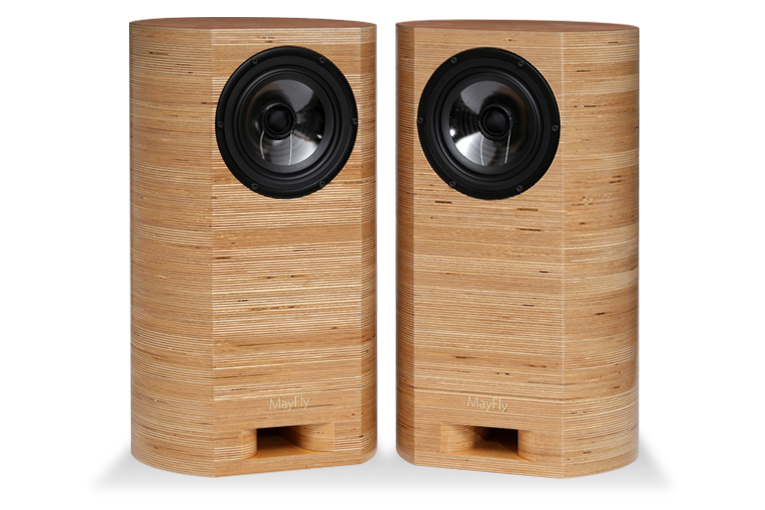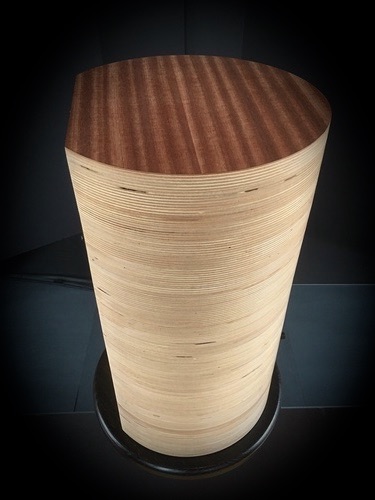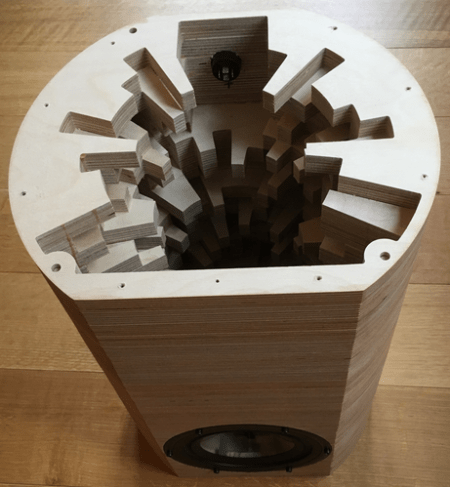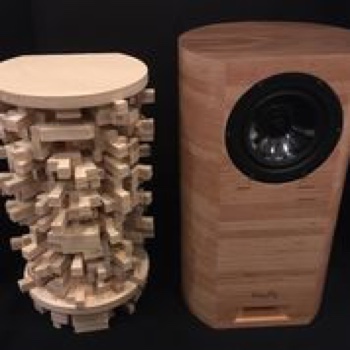
The CNC cuts for the cabinets and the internal skyline diffusers of the MF-201A speakers were the first features that grabbed my attention. I have never before seen a speaker with internal diffusers that are as complicated and refined as those of the MF-201A.
They are more than just simple square diffusers that one can calculate using an online tool. There is real thought and reasoning behind this design. It intrigued me, and I wanted to hear it. I also wanted to know more about how they were made. And, as if all that wasn’t enough, the MF-201A uses a see-through coaxial driver. I have a weak spot in my ear for full-range coaxial drivers. This one is even made from a clear polymer, so you can see some of the diffusers behind it. How great is that!
Trevor May is the owner, designer, and craftsman behind MayFly Audio Systems, and Paul Muto represents the line in the United States. Thankfully, they were happy to send me a pair so that I could listen and review them. So, let’s get on with the review.
But where to start? The sound? The design? And, who is Trevor May, anyhow?
About Trevor May
Hailing from Ottawa, Canada, Trevor has both his BSc and MSc from the University of Alberta. He earned his MBA from Queen’s University, and he has a long professional career in both software and engineering roles. Through his audio passion, he has built many musical instruments, amplifiers, microphones, mixing consoles, and effects.
I wouldn’t normally bring up someone’s education and professional background. Here it shows that Trevor has the engineering, mathematical, and musical chops to take an idea like the skyline diffuser and create something new, unique, and purposeful, from it. See, this is the thing, if you use a diffuser to alter the sound in a cabinet, you have to know a good amount about how sound physically works.
I asked Trevor if he was really able to model the effect of the 24×24-inch internal diffuser on the SEAS T18REXXFC coaxial driver, or if he just experimented until he found what he liked? He said that while he was able to, it was “pretty difficult”. He also said that he relied on “a lot of experimentation” alongside the modeling. Specifically, the effect of the non-right angle and conical fingers inside the diffuser was difficult to measure. Listening tests tuned the speaker more to his liking.
The Idea Behind the MF-201A Speakers
Trevor didn’t start with a round shape or even a coaxial driver. He started with the idea of using a skyline diffuser in a bass-reflex-designed cabinet to control the back wave from the driver. Starting first with a box and a normal square style diffuser, and over many iterations, he arrived at where the MF-201A is today. He added the round shape of the speakers to reduce cabinet reflections and diffractions.

He added the coaxial driver later. It accounts for an “audible comb filtering at different listening angles, especially up and down”), or lobing effects. Also, since a CNC makes each layer of the speaker, the bass port is the speaker wall, so to speak. This helps eliminate port resonances. It uses an asymmetric, two-pole crossover to tune the 180mm polymer cone woofer and a 26mm fabric dome tweeter.
Unfortunately, the review opportunity didn’t come with a set of speakers without the diffuser to A/B test the against. I have to take the speaker, as do all other reviewers, just as it comes.
MF-201A Cabinet Design
MayFly speakers start with a cabinet made from high-quality birch plywood. A CNC cuts the round external shape, and the fingers of the diffuser internally. The layers of the plywood are then placed in a specifically made jig to align everything correctly, and they are then glued together. The port is front-firing and appears to have one 90-degree bend in it. The finish to the speaker, a craftsman’s French Polish is used to give the speakers a very natural wood look, even though they are constructed from cross-sections of plywood. The final result is a speaker with a mid-century modern design (not that I know anything about modern design) and a hefty weight. It is as eye-catching on the outside as it is on the inside.

Review System
I had three integrated tube amplifiers during the review period to pair with the speakers. The source was my PecanPi DAC and Rega P3/24 turntable with a SoundSmith Carmen V1 cartridge and a V1 make of the MMP3 phono amplifier.
My listening room is small, only 10ish x 11ish-feet. It does have a fair amount of absorption, diffusers, and bass-trap treatment. The hardest thing in the world seems to be making a small room sound big. I don’t need a lot of power for my listening space, as it quickly becomes overwhelmed at higher volumes or too large a speaker. My lower-powered tube amplifiers should be just fine. The amps included my recently purchased Rogers 65V-2 using mainly the EL34 tubes, an Audio Note OTO PP, and a Mystier ia11, which is another EL34 amplifier.
I also toggled between the WyWires Platinum Litz wire speaker cables and MG Audio copper ribbon speaker cables. The WyWires sounds a bit more lively than the MG Audio, so the MG Audio cables paired better with the Rogers amplifier and the WyWires with the Audio Note and Mystier. I ran lossless FLAC files from CD rips using abcde (https://abcde.einval.com/wiki/) off of a Raspberry Pi and Volumio. Power was supplied by a dedicated outlet with a Vermouth Reference power cord (reviewed here) going right into the amplifier. All of the front end was plugged into an Audience forte V8 power strip (reviewed here).
Speaker Placement
I unpacked the speakers and set them up about one foot from the sidewalls and two feet from the back walls. About three weeks into the review, I added ATS triangle bass traps in the corners behind the speakers. I sat the speakers on stands to get the driver at ear level. I used my own stands as these speakers are about as tall as my Lowther Acousta 90 cabinets. However, the MF-201A can come with its own stand made and finished in the same look and shape as the speaker itself. It makes for a beautiful stand-mount, floor-standing speaker setup. The binding posts on the rear were easy to deal with. I toed the speakers in somewhere between 10-30 degrees.
My Playlist
When it comes to listening to music to review a set of speakers, I’m consistent in my choices. So, my playlist includes:
Dead Can Dance’s Towards the Within (https://www.discogs.com/Dead-Can-Dance-Toward-The-Within/master/14693)
Jennifer Warnes Famous Blue Raincoat (https://www.discogs.com/Jennifer-Warnes-Famous-Blue-Raincoat-The-Songs-Of-Leonard-Cohen/master/104357)
Heifetz’s Tchaikovsky-Mendelssohn (https://www.discogs.com/Heifetz-Tchaikovsky-Mendelssohn-Reiner-Munch-Tchaikovsky-Mendelssohn-Concertos/release/8332370)
Air’s Le Voyage Dans La Lune (https://www.discogs.com/AIR-Le-Voyage-Dans-La-Lune/master/411238)
Daft Punk’s R.A.M. (https://www.discogs.com/Daft-Punk-Random-Access-Memories/master/556257).
Of course, I listened to much more music, everything from Slayer to Gui Boratto, to Tinariwen and Miles Davis. I just seem to always come back to the above five for opinionated listening.
My Impressions of the MF-201A Speakers
I pressed play on Volumio as I sat down in an old leather armchair. As the music started to come in and reach full volume, I was floored by the power and variety of the bass I heard. Diego Estan, who reviewed these speakers for SoundStage Hifi, and I are in complete agreement. I have never heard this kind of bass from a stand-mount speaker, either. It actually makes me wonder if what I have grown accustomed to is a result of my small listening space and the issues that lack of size creates and the speakers I tend to choose to listen to in that smaller space. I’ll be thinking about that, but, pardon my programming slang, there’s no need to rubber duck it out here.

The MF-201A bass rivals that of full-sized, floor-standing speakers and it doesn’t suffer from bloat or sluggishness. It is chest-pounding, growling, all surrounding, and just damn fun!
Is it overwhelming to the point of being too forward or overpowering? This is where things get tricky. In my listening room, one might make the argument that without bass traps, it can be. As mentioned above, I did add two ATS bass traps halfway through the review. I didn’t order them specifically for the MF-201A speakers, but rather to control the bass better in my small room, which in turn opens up the mid-range and bass details. And with the ATS traps in the room and the MF-201A speakers putting out about as high a volume as I like, the bass was still very powerful and chest pumping, but more controlled and allowed the mid-range, which I found to be a bit relaxed, to come forward more. But, on the other hand, one might also like to relive their youth spent in club basements, throbbing to drum-and-bass and savage dubstep. Gui Boratto’s III album took me to a whole other world where the physicality of the music was as tangible as the chair I was sitting in and the drywall of the room. The MF-201A are compelling in their power.
Other Styles of Music
But, how did the MF-120As do with other styles of music? Actually, very good. I played piano, vocals, male and female, rock and avant-garde pop music, and it all sounded fun and lively. What the speakers might lack in detail, they made up for in tonality and appeal. The sound was like a live venue on a Saturday night. There was enough detail and dynamics there to get across the emotion of the music as well as some of the mistakes. But, these aren’t like riding the edge of a microphone diaphragm. My Lowther PM2A drivers are that way. It can be cutting, at times.
The highs were also coherent and lively, but I would say, at least with the amps and front-end equipment I paired them with, the MF-120As might have leaned a bit more to the polite and gentle. Yes, Billy Corgan’s voice on Mellon Collie And The Infinite Sadness is still nasally and obnoxious, but I didn’t get sidetracked by just how nasally and obnoxious it is (sorry Billy) nor by some of the shoddy production work in the recording. Eek!
Clear and Coherent Soundstage
What is great about the coaxial drivers used in these speakers is that they present such a clear and coherent soundstage and a big listening sweet spot. While the scale and size of the music might be debatable, these speakers handled single-musician recordings and large orchestral pieces, better than average for the price point.
I thought the mid-range staging and presentation might be the speaker’s weak spot, at least in my listening space. The addition of the bass traps did in fact let the mid-range come out and be more forward. .Some might call it relaxed in its presentation, while the bass was fully present, and the highs did a good job of coming into attention and receding again as the music flowed, the mid-range seemed to hang back a bit more, in the staging presentation.
Conclusion
Overall, I liked these speakers a lot but would be cautious with them in a small room. I did ask Trevor what size rooms he tested the speakers in, but I don’t believe any were as small as mine. And I didn’t read any other reviews with such a small room.
As a side note, an interesting thing stood out to me about Trevor’s response when I asked him if this diffuser idea would work in all speaker cabinet types? Is this a technology, an idea, that should be incorporated into every speaker? In short, he said no. It is used here for a specific purpose and other cabinets and speaker combinations might not require something like an internal diffuser. I liked this answer. He wasn’t trying to sell an idea where it was not needed.
The Mayfly speaker line includes the MF-201A stand-mount speakers, their larger pairing woofers, and the MF-301 (not reviewed). The MF-201As are the first MayFly production speakers available for purchase. If these speakers sound interesting to you, I would encourage you to connect with Trevor or Paul and arrange a way to hear them. They offer a lot of value for their price, not only in visual appeal but lively and fun sounds. I look forward to seeing how these speakers evolve, or more speaker designs, that come from Trevor over the years. Congrats to him for making something new!
Price: $3,500 USD per pair.
Contact:
Trevor May – Chief Designer, Mayfly Audio Systems, Ltd.
www.mayflyaudio.com
tmay@mayflyaudio.com
Paul Muto, US Sales and Marketing for MayFly Audio
paul@mutocomm.com
516.662.5374
Twitter @MutoCommPR
